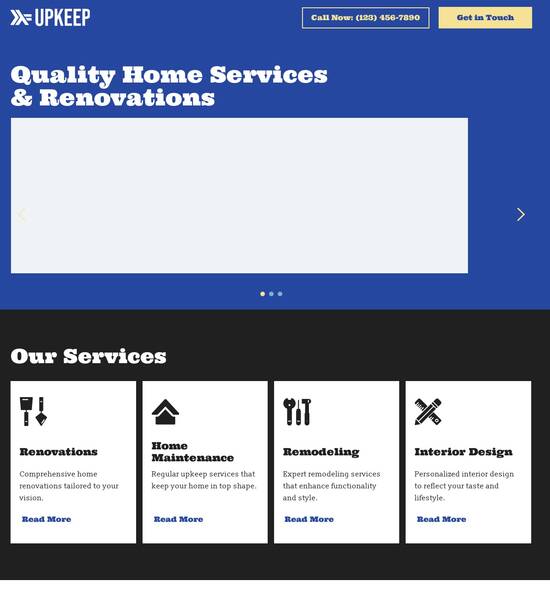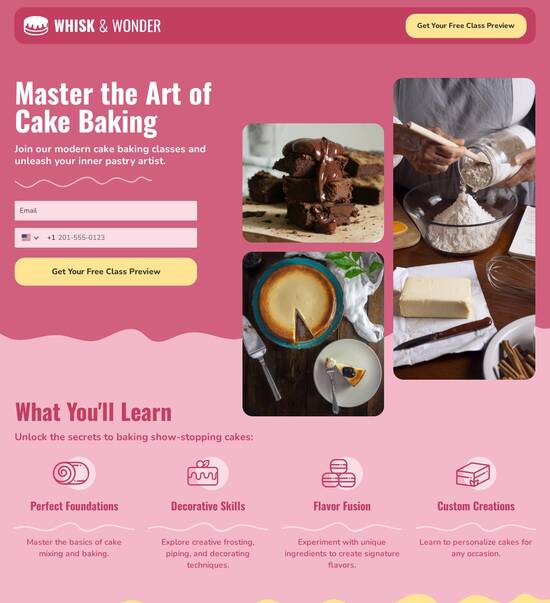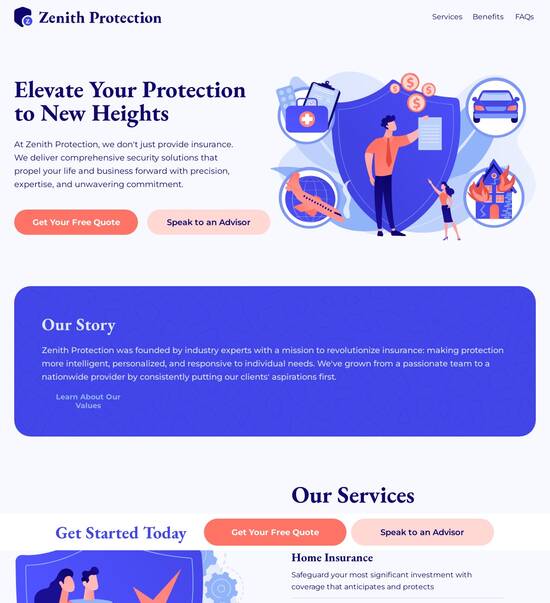
Landing page template for Search engine optimization
Use TemplateAbout template
Attract clients and showcase your skills with style using our landing page templates for Search engine optimization. Let's convert those visitors into clients!
Recommended templates

Easy to build without coding
With the intuitive drag-and-drop builder, anyone on your team can create high-converting pages without any knowledge of code or design. Make enhancements to your landing page with custom widgets using Javascript, HTML/CSS, or third-party scripts.

Multiple layouts for any industry and goal
Select from 500+ landing page layouts built to boost conversions across industry-specific scenarios. Customize them by adjusting fonts, adding images, and generating on-brand content with the AI assistant. Quickly scale with Instablocks® and Global Blocks that you can save, reuse, and update globally.

Loads fast and looks polished on any device
Every template is responsive, which means they present professionally on any device and load blazingly fast with our Thor Render Engine. You can also power them up with Google AMP technology to deliver an unparalleled mobile experience and drive higher conversions.

Robust analytics & experimentation
Get real-time updates and reporting across all your devices, showing the number of visitors, conversions, cost-per-visitor, and cost-per-lead. Launch AI-powered experiments, run A/B tests, and use heatmaps to analyze user behavior, then optimize your landing page to maximize conversions.







Easy to build without coding
With the intuitive drag-and-drop builder, anyone on your team can create high-converting pages without any knowledge of code or design. Make enhancements to your landing page with custom widgets using Javascript, HTML/CSS, or third-party scripts.
Multiple layouts for any industry and goal
Select from 500+ landing page layouts built to boost conversions across industry-specific scenarios. Customize them by adjusting fonts, adding images, and generating on-brand content with the AI assistant. Quickly scale with Instablocks® and Global Blocks that you can save, reuse, and update globally.
Loads fast and looks polished on any device
Every template is responsive, which means they present professionally on any device and load blazingly fast with our Thor Render Engine.
Robust analytics & experimentation
Get real-time updates and reporting across all your devices, showing the number of visitors, conversions, cost-per-visitor, and cost-per-lead. Launch AI-powered experiments, run A/B tests, and use heatmaps to analyze user behavior, then optimize your landing page to maximize conversions.
All the features you need to build search engine optimization example
Explore more featuresLearn how to build search engine landing page
FAQs
Leading the way in building high-performing landing pages





Creating effective landing pages with Instapage for maximum conversion rates
In the competitive landscape of digital marketing, leveraging Instapage’s powerful landing page capabilities can significantly enhance your campaign outcomes. This step-by-step guide will explore how to utilize Instapage effectively to create high-converting landing pages tailored for your target audience in various industries, including business services, tech, education, and more.
Step 1: Understanding your audience
To create impactful landing pages, begin with a deep understanding of your audience. Identify their pain points, preferences, and behaviors. Instapage offers advanced data tools to help you analyze audience metrics, ensuring your designs resonate with users’ needs.
- Segmentation: Separate your audience based on demographics and behavior to tailor content.
- Engagement metrics: Utilize heatmaps to analyze which areas of your page attract the most attention.
- Feedback: Use real-time collaboration features to gather insights from team members.
Step 2: Choosing a template
Instapage provides over 100 customizable templates designed for optimization. Pick templates that align with your marketing goals while ensuring mobile responsiveness.
- High-converting layouts: Focus on templates that have proven success in your niche.
- Customizability: Choose templates that allow for easy edits to match your branding.
- Lead capture elements: Ensure templates include integrated forms and call-to-action buttons.
Step 3: A/B testing for optimization
After launching your landing page, implement A/B testing to evaluate different variations. Analyze the performance of each version, focusing on conversion rates and engagement levels.
- Define variables: Test one element at a time, such as headlines, images, or CTA buttons.
- Use analytics: Leverage Instapage’s built-in dashboards to gather data on each version’s effectiveness.
- Iterate: Make informed adjustments based on testing results to refine your landing pages.
By following these steps and utilizing Instapage’s robust features, you can create landing pages that not only attract visitors but also convert them into leads and customers.
Concluding, optimizing your landing pages using the right tools and strategies can dramatically improve your digital marketing performance.
Ready to maximize your ROI? Start building your first landing page with Instapage today and experience the difference in your marketing campaigns!
People also ask about Landing page template for Search engine optimization
Harnessing the power of SEO through innovative landing page templates
Unveiling the importance of SEO in landing pages
Landing pages play a crucial role in digital marketing strategies. They serve as dedicated web pages designed specifically for lead generation and conversion, usually linked from ads or emails. Ensuring they're well-optimized for search engines is vital, as this directly impacts how potential customers discover your offerings. When done correctly, the right landing page can attract high-quality traffic, enhance the user experience, and drive conversions.
Search engine optimization (SEO) enhances visibility by making your landing pages more attractive to search engines. This is achieved through various tactics, including effective keyword usage, optimization of HTML elements, and creating relevant, high-quality content. When a landing page is optimized, it ranks higher in search engine results, making it easier for users searching for related keywords to find you.
Studies show that companies with optimized landing pages see a conversion increase of over 30%.
SEO-optimized landing pages can lead to a higher ROI on digital marketing efforts.
According to recent reports, businesses that prioritize SEO are 13 times more likely to see positive ROI.
Key components of an SEO-optimized landing page template
Creating a robust SEO-optimized landing page template revolves around several key components that must be integrated effectively. The first and foremost aspect is keyword integration. Identifying target keywords relevant to your audience and industry should be the foundational step. Aim to integrate these strategically throughout your landing page, from headers to body text, ensuring they enhance both readability and search engine ranking.
The placement of keywords is essential; start by including primary keywords in the page title and H1 headings. Subsequently, utilize secondary keywords in subheadings and body content, ensuring it flows naturally. Additionally, including keywords in metadata, such as title tags and meta descriptions, enhances your visibility in search engine results.
Compelling headlines and meta descriptions
Crafting compelling headlines and meta descriptions can drive higher click-through rates. A headline should not only be attention-grabbing but also clear about the content that follows. Use action-oriented language and focus on the benefits for the user. Keep it concise; headlines should ideally be under 60 characters to ensure they display well across search results.
Meta descriptions, while not a direct ranking factor, significantly impact click rates. A well-written meta description summarizes the content and encourages users to click. Utilize about 150-160 characters for optimal display, enriching your description with targeted keywords without sounding spammy or forced.
Engaging multimedia elements
Engaging multimedia elements, such as images and videos, enhance user experience significantly. They can break up text-heavy sections and illustrate your points more vividly. However, these elements must be optimized for SEO as well; ensuring your images are correctly named and that appropriate alt text is added can improve your ranking potential.
File names should describe the content succinctly, incorporating keywords where relevant. Additionally, using lightweight PDFs and eBooks as downloadable content can enrich the user experience and add value, helping to attract and retain visitors.
The role of a dynamic editor in landing page creation
A professional editor is essential in developing landing page templates that are not only visually appealing but also functional and effective for SEO. One of the standout features of a dynamic editor is drag-and-drop functionality. This enables users, even those lacking coding knowledge, to customize templates intuitively. It simplifies the design process, allowing marketers to execute their ideas without delay.
Moreover, responsive design capabilities are critical. Templates that adapt seamlessly across devices improve user experience, which is increasingly important as mobile usage continues to rise. When creating landing page templates, it’s vital to adhere to ethical guidelines, ensuring that all content created using the editor is not only accessible but also user-friendly.
Utilizing flowcharts for strategic content layout
Flowcharts can be invaluable for visualizing the structure and user journey on your landing pages. They assist in laying out content logically, ensuring intuitive navigation and guiding users through the desired actions. Establishing a clear hierarchy of information is essential; each section should lead people naturally to the next, driving engagement and ultimately conversions.
Best practices suggest using flowcharts to map out primary calls to action and how users might interact with your content. This helps identify gaps or bottlenecks in your layout that may deter users, making it easier to refine your content strategy for optimized engagement and conversion rates.
Effective use of converters in SEO strategy
Converters can play an essential role in enriching the content offerings of landing pages. One practical approach is converting static content, such as PowerPoint presentations or Word files, into interactive formats that engage users more effectively. This not only enhances the user experience but encourages longer dwell times, which can positively influence SEO rankings.
Additionally, transforming spreadsheets into visual data representations can make complex information more digestible. By providing users with engaging formats, you maintain interest and improve understanding. It’s important to ensure that quality and formatting are maintained during these conversions, as poorly executed conversions can lead to loss of credibility and user trust.
Leveraging diagrams and graphics for SEO enhancement
Business diagrams and visually engaging graphics are powerful tools in breaking down complex concepts. They promote higher engagement levels, making them an excellent supplement to textual content. Infographic-style content, when optimized for SEO, can significantly improve traffic and engagement metrics. A well-designed infographic can be easily shared across platforms, driving more visitors to your landing page.
When creating visual content, consider SEO strategies such as including relevant keywords in the file name and optimizing alt text for images. This ensures that search engines can crawl your visuals effectively, helping improve their searchability and boosting the overall visibility of your landing pages.
Advanced tools for continuous optimization
To ensure the ongoing success of your SEO strategy, it’s critical to utilize advanced tools that aid in tracking landing page performance. Analytics tools provide insights into user behavior—highlighting what parts of your landing page are performing well and which areas need improvement. Understanding user interactions can guide future adjustments and refinements, enhancing overall performance.
A/B testing tools facilitate iterative changes, allowing you to tweak elements and measure their impact on conversion rates. These tools provide invaluable feedback, ensuring that the landing page continuously evolves based on real user data, thus optimizing for better SEO outcomes.
Insights derived from data-driven decisions
Gathering and analyzing data is foundational for informing landing page updates. Effective use of data can reveal patterns and preferences that may not be immediately apparent through standard observation. By paying attention to metrics such as bounce rates, average time on page, and conversion rates, you can pinpoint areas that require attention or adjustments.
Case studies of successful optimization strategies abound, illustrating how data-driven decisions facilitate remarkable improvements. By understanding user behavior and preferences, marketers can create tailored experiences that resonate with specific audiences, leading to better outcomes in terms of both engagement and conversion rates.
Common mistakes and how to avoid them
As beneficial as optimized landing pages can be, common pitfalls still persist. One major mistake is overlooking mobile optimization; with increasing mobile usage, landing pages that aren’t mobile-friendly risk alienating a significant portion of users. Additionally, keyword stuffing is a frequent error that can lead to decreased rankings rather than improved visibility. Ideally, keywords should be integrated organically.
Another common oversight is neglecting to track and utilize data effectively. Without proper analysis, marketers may miss out on critical insights that could enhance performance. To avoid these pitfalls, prioritize mobile responsiveness from the beginning, focus on natural keyword integration, and establish regular data review practices to inform and refine your strategies.
Future trends in SEO landing page design
Looking ahead, the landscape of SEO practices in landing page design is poised for continual evolution. Emerging technologies, especially artificial intelligence and machine learning, promise to significantly broaden the scope of optimization strategies. These tools enhance the ability to analyze vast amounts of data, predicting user behavior and preferences more accurately.
As user experience continues to be a priority, flexibility in design and content personalization will become even more paramount. Marketers who can creatively harness these technologies within their landing page templates will likely excel, staying ahead of the curve in an increasingly competitive digital marketplace.
Ready to skyrocket conversions?
Supercharge your ad campaigns with high-performing landing pages
Get started














